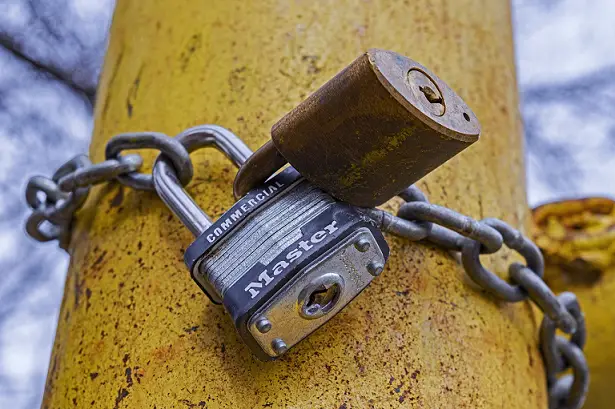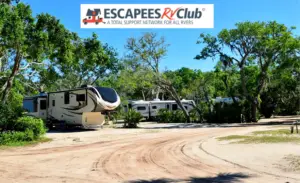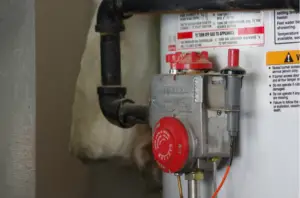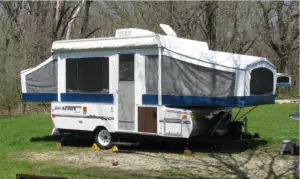Modern RVs allow one to use a wide range of electronics and appliances. Due to the sensitive nature of electrical appliances, you need to ensure the voltage supplied is optimal and reliable. That’s why an RV surge protector is a must-have if you want to avoid losses caused by voltage issues.
Unfortunately, a surge protector, which is often kept outside of an RV at the power outlet, is a high-theft item- opportunistic thieves often steal it. Therefore, you need to have a good quality locking mechanism or even a lock combination to keep it secure.
In this article, let me explore various ways you can secure your surge protector.
1. Use A Tough Bicycle Chain And A Padlock
The cheapest and most effective method of securing a surge protector is using a rugged bicycle chain and padlock. This might be an old way of securing things, but it still works and is perfect.
A robust and quality bicycle chain and a high-security padlock will give any opportunist thief a hard time. Don’t compromise on the quality of the bicycle chain- the chain should be solid and thick so it can’t be cut with bolt cutters.
Only a grinder can cut a thick chain, and this would only take a daring thief as the noise will be too obvious.
You can easily get quality bicycle chains in local hardware stores or online.
To secure your surge protection unit using a chain and padlock, run it around the electrical outlet post, rotate it around the cord, and then put the padlock through the chain links to lock the chain.
To double the security, you can add another chain on the bottom part of the surge protector and secure it with a padlock in the same way you secured the top side.
2. Using A Cable Lock
Another popular way campers use to secure their RV surge protector is by using a locking cable. This type of lock is popular thanks to its ease of usage.
When buying a cable lock, make sure it is designed for outdoor usage (weatherproof), has a strong lock, and several keys.
The cable lock should be made of quality material (preferably steel), and it should have a rust-resistant coating.
A cable lock is not as secure as a bicycle chain and can be sliced using bolt cutters. Luckily, it’s rare for opportunistic thieves to carry bolt cutters with them. After all, there are many unsecured RV surge protectors they can steal without any hassle.
The whole point of these cheap thieves is to break in with the least amount of effort- no damage or load noises.
To use a cable lock, place the cable around the power outlet post and firmly wrap it around the electrical cord of your surge protector. Ensure to feed the cable through the open tunnel to create a tight loop (there should be no slack). Lock it up with the key once done.
Again, to double the security, use two cable locks
- one tightening the top
- and the other tightening the bottom part of the surge protection box.
Make sure to regularly apply lubricating oil to the lock to keep it from rusting.
3. Invest In A Lockbox
Surge protector manufacturers have come up with lockboxes to help their customers keep surge protectors safe when you are away from your RV or inside.
The lockbox covers the surge protectors so that no one can access them without a key unless they dismantle the whole unit apart. Of course, dismantling the unit will be time-consuming and noisy.
This type of lock should secure the bottom part of the surge protector, which means you will need to use a chain lock or cable lock to secure the top part of your surge protection unit.
Some manufacturers include a padlock in their lockboxes, while others don’t.
In case the included padlock is not quality, you can invest in a high-security padlock.
The box is spacious and thus can accommodate both the surge protection unit and its power cables and lock them to the electrical pedestal.
When buying a lockbox, make sure it is made from high-quality metal, has enough room to accommodate the plugs and power cords that go to your unit, and is easy to install. Often, manufacturers include a user manual that you can use to secure your surge protector.
4. Use A Ball Plug Lock
This type of surge protector lock is quite similar to a lockbox, but instead of having a box shape, they are box-shaped.
Just like the lockbox, this too should be used together with a chain-type lock or cable lock around the top to protect plugs and electrical cables going into your protector.
This type of lock is not only great for deterring opportunist thieves who don’t carry bolt cutters with themselves but also for keeping naughty children from unplugging your power cords.
They are easy to smash, but as we said earlier, opportunist thieves are always looking for the most hassle-free way of stealing things and thus won’t both attract unwanted attention by breaking into a ball plug lock.
In most cases, this type of lock comes with a padlock, but you will often find them pretty lightweight. You can invest in a high-security padlock to beef security.
Manufacturer provides instructions for installing this type of lock in their user manual. Don’t forget to add a chain lock to secure the top of your surge protection unit as well.
Conclusion
A surge protector is a must-have unit in an RV as it keeps your expensive appliances and electronics safe from any electrical defaults. Without it, you will be risking damaging your expensive appliances.
That’s why it is important to secure it with any of the above methods we have discussed, as they are highly vulnerable to thieves.
All the methods we have discussed here will deter opportunist thieves from stealing your investment and will also keep naughty children from unplugging wire cables.
Make sure to invest in a high-security padlock to make it harder for thieves to access your unit.





